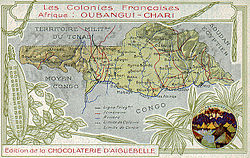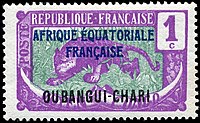Ubangi-Shari
| Ubangi-Shari Oubangui-Chari | |||||||
|---|---|---|---|---|---|---|---|
| Constituent of French Equatorial Africa | |||||||
| 1903–1958 | |||||||
 Green: Ubangi-Shari (prior to 1916) Lighter green: Ubangi-Shari (1916 concession from Kamerun) Lime green: French Equatorial Africa Dark gray: Other French possessions Darkest gray: French Republic | |||||||
| Anthem | |||||||
| La Marseillaise • La Renaissance (instrumental only) | |||||||
| Capital | Les Abiras (1903–1906) Fort de Possel (1906) Bangui | ||||||
| History | |||||||
• Established | 1903 | ||||||
• Merged with Chad | 1906 | ||||||
• Merged into French Equatorial Africa | 1910–1916 | ||||||
• Separately administered | 1916–1934 | ||||||
• Merged into French Equatorial Africa | 1934–1958 | ||||||
• Autonomy | 1 December 1958 | ||||||
| |||||||

Ubangi-Shari (1906−1958) (Template:Lang-fr) was a French colony in central Africa, a part of French Equatorial Africa.
It was named after the Ubangi and Chari rivers along which it was colonised. It was established on December 29, 1903, from the Upper Ubangi (Haut-Oubangui) and Upper Shari (Haut-Chari) territories of the French Congo; renamed the Central African Republic (CAR) on December 1, 1958; and received independence on August 13, 1960.[1]
History

French activity in the area began in 1889 with the establishment of the outpost Bangi (now Bangui) at the head of navigation on the Ubangi.
The Upper Ubangi was established as part of the French Congo on December 9, 1891. Despite a France-Congo Free State convention establishing a border around the 4th parallel, the area was contested from 1892 to 1895 with the Congo Free State, which claimed the region as its territory of Ubangi-Bomu (Oubangui-Bomou). The Upper Ubangi was a separate colony from July 13, 1894, until December 10, 1899, at which time it was folded back into the French Congo. The Upper Shari region was established as part of the French Congo on September 5, 1900.[1]
The territories were united as the separate colony of Ubangi-Shari on December 29, 1903,[1] following the French defeat of Abbas II of Egypt, who had claimed the area.[citation needed] On February 11, 1906, this colony merged with the French settlements around Lake Chad and became the Ubangi-Shari territory of Ubangi-Shari-Chad (Oubangui-Chari-Tchad).[1] In 1909, it received the administration over the sultanates of Zemio and Rafai from the Belgian Congo.[2]
On January 15, 1910, this administration was merged with the French Middle Congo and Gabon as the Ubangi-Shari area of French Equatorial Africa (FEA). On April 12, 1916, it again became the separate colony of Ubangi-Shari, but lost the territory around Lake Chad in 1920 and was again folded into FEA on June 30, 1934. As a part of FEA, it was declared an overseas territory on December 31, 1937.[1]
Between 1915 and 1931, stamps were overprinted for use in Ubangi-Shari, and later specially printed for the colony.
During World War II, it remained loyal to Vichy France from June 16 to August 29, 1940, before being taken by the Free French. It was granted autonomy as the Central African Republic on December 1, 1958, and independence under the same name on August 13, 1960.[1]
See also
References
- ^ a b c d e f World Statesmen. "Central African Republic." Accessed 29 Mar 2014.
- ^ World History at KMLA. "Central African Republic". Accessed 29 Mar 2014.
External links
- 1870–1960 timeline
- 1891–1960 timeline at World Statesmen
- States and territories established in 1903
- States and territories disestablished in 1958
- Ubangi-Shari
- French Equatorial Africa
- Former colonies in Africa
- Former French colonies
- French colonisation in Africa
- History of the Central African Republic
- Chari River
- 1903 establishments in French Equatorial Africa
- 1958 disestablishments in French Equatorial Africa
- Central African Republic–France relations



